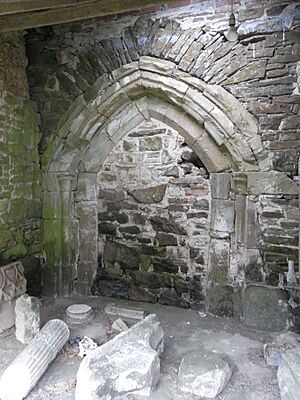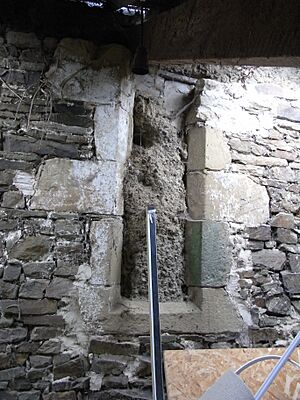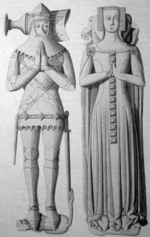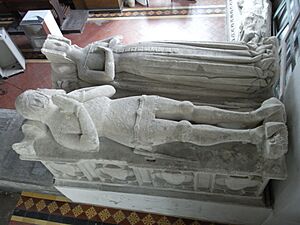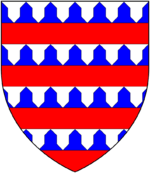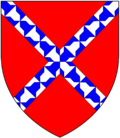Holy Trinity Chapel, Umberleigh facts for kids
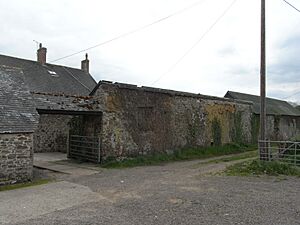
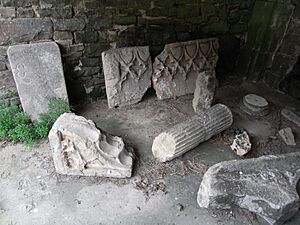
The Chapel of the Holy Trinity at Umberleigh is a very old chapel in north Devon, England. It is mostly in ruins today, as much of it was taken down around 1800. The chapel stands right next to Umberleigh House, which was once the main house of the Umberleigh estate. Umberleigh House is now a large farmhouse built in the Georgian style.
Both the chapel ruins and Umberleigh House are considered very important historical buildings. They were given a special "Grade I listed" status on February 25, 1965. According to Tristram Risdon, a historian from Devon who lived in the 1600s, this place was once a royal palace belonging to the Saxon King Athelstan. Later, it became a large mansion house owned by several important families over time. Today, the chapel, the main house, and the surrounding land belong to the Andrews family. They bought the property in 1917, but their family had been renting it since about 1840. The south wall of the chapel is still standing and is now part of a storage building.
Contents
Founding the Chapel
The Umberleigh Chapel of the Holy Trinity was started by Lady Joan Willington. She was also known as Joan Champernowne. She was the daughter of Sir William Champernowne of Umberleigh. Lady Joan founded the chapel sometime before she passed away around 1314.
She created a special document, or "foundation deed," to explain why she built the chapel. This document was mentioned by the historian Tristram Risdon in his book A Survey of Devon in 1630. In this document, Lady Joan said that she was giving land to support a chaplain. A chaplain is a priest who would hold religious services in the chapel. She did this for the well-being of her own soul and the souls of her family members, including her father, mother, and her late husband, Sir Ralph Willington.
Old Monuments and Tombs
Over many centuries, important people were buried in Umberleigh Chapel. Their tombs and monuments were placed there. However, around 1820, most of these monuments were moved to Atherington Church, which is nearby.
In about 1753, someone living at Umberleigh described the chapel and its contents. They noted three main tombs. Here's what we know about them:
The Lost Knight's Tomb
- This tomb was near the entrance on the south side of the chapel.
- It had a statue of a knight with his legs crossed, raised slightly above the ground.
- Sadly, this monument is now lost.
The Knight and Lady Effigies
- This tomb was in the north-east corner.
- It featured figures (called effigies) of a man in armor and his wife.
- The front of the tomb was decorated with small carved spaces, each with a shield that once had painted family symbols (coat of arms).
- These two effigies are now in Atherington Church. They lie side-by-side on a new base.
- Historians have debated who these figures represent. Some believe they are Sir Ralph Willington (who died in 1385) and his wife. Others suggest they are Sir Henry de Willington and his wife, Lady Isabella.
- The knight's armor shows the Willington family's coat of arms: a red shield with a white and blue diagonal cross.
The Crusader Knight Effigy
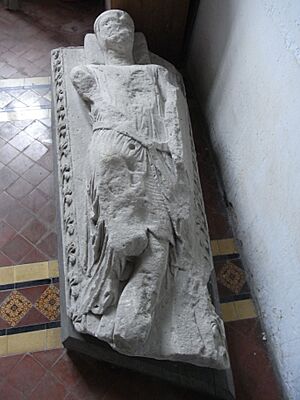
- This figure was found under the south wall.
- It shows a knight with his legs crossed, wearing chain armor and a loose vest.
- He holds a long, pointed shield.
- Knights shown with crossed legs are often thought to have been crusaders, who traveled to the Holy Land for religious wars.
- This effigy is from the 1200s. It is now in Atherington Church, lying on the floor.
- It is believed to represent Sir William de Champernowne, who was Lady Joan Willington's father.
Tristram Risdon, writing around 1630, also described the chapel and its contents. He noted that many of the lords of Umberleigh were buried there in beautiful tombs. He mentioned that in his time, only two main tombs remained. One had the figures of a knight and his lady, decorated with their family symbols. The other had a fully armored knight lying with crossed legs, like those who went to war in the Holy Land. Risdon also noted that by his time, there were no inscriptions left to say who these people were.


